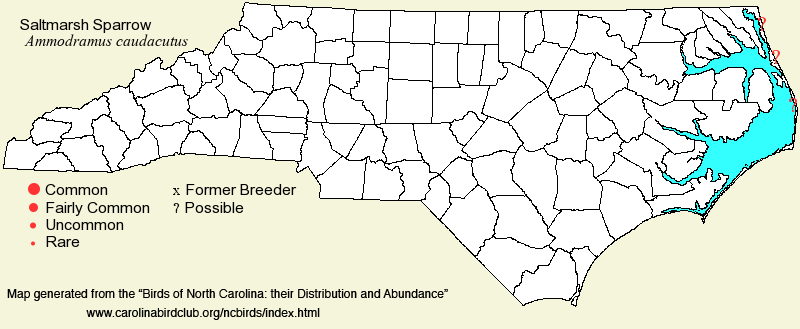 |  |
|
Saltmarsh Sparrow - Ammospiza caudacuta PASSERELLIDAE Members: | Search Common: Search Scientific: |
|
|
|||||||
| General Comments | This species was split, along with Nelson's Sparrow, from the Sharp-tailed Sparrow in 1995. Whereas the Nelson's has populations in the middle of the continent plus the Northeastern states and Canadian Maritimes, the Saltmarsh Sparrow is the former subspecies that nests along the Atlantic coast from Virginia northward. Though a few birds have been reported in North Carolina marshes in Jun, there is no evidence of nesting here. In fact, juvenile Seaside Sparrows can look quite similar to Saltmarsh Sparrows, and thus some summer reports of Saltmarsh Sparrows might be misidentified. Both the Nelson's and Saltmarsh sparrows winter in salt and brackish marshes along the South Atlantic coast, including North Carolina; both appear to be about equally numerous, though local abundances are still to be worked out. Whether the Saltmarsh Sparrow occurs inland (in migration) is uncertain, as older records of Sharp-tailed did not differentiate between subspecies; however, the coastally nesting Seaside Sparrow, as has the Clapper Rail, been found inland, mainly as tower-kill victims. Thus, there likely are a few inland state records of Saltmarsh Sparrow. NatureServe moved the Global Rank to an alarming G2 in the past few years, and the N.C. Natural Heritage Program has followed suit by moving the State Rank for wintering birds to S2N, which seems too rare for a bird that is not overly scarce in winter in our marshes. In addition, that program is now tracking the wintering population as Significantly Rare (it does not nest in NC). The website editor suggests more common sense and that the species should remain on the Watch List and that the State Rank should be closer to S3N, especially as a number of other Atlantic coast states have an S3 State Rank, and as this species seems to be about equally as numerous in our coastal marshes in winter as the Nelson's Sparrow and the Seaside Sparrow, both with S4 State Ranks. | ||||||
| Breeding Status | Nonbreeder (but Possible Breeder) | ||||||
| NC BRC List | Definitive | ||||||
| State Status | SR [W] | ||||||
| U.S. Status | |||||||
| State Rank | SUB,S2N [SUB,S3N | ||||||
| Global Rank | G2 [G3?] | ||||||
| Coastal Plain | Winter resident; possible breeder, but no confirmation. In summer, 4 were seen at Pea Island NWR, from 21-30 May 1995, with one seen carrying a fecal sac. However, this is a heavily birded site, with no other likely suggestions of nesting, unless one at that refuge on 28 Jul 1996 was a breeding bird. In winter, status tentatively the same as for Nelson's, pending further "research"/study: fairly common to common along the southern half of the coast (south of Cape Lookout), and fairly common northward along the coast. Also, scarce (uncommon?) in brackish marshes fringing the inner portions of Pamlico Sound; poorly surveyed in these "inner" marshes. Away from tidal marshes, status unknown, but likely absent to casual in migration. It is hoped that several tower-killed birds, if residing now in museums, can be (or have been) re-examined to determine if they are Nelson's or Saltmarsh. Mainly mid-Sep to late May, and a few lingering into Jun. Peak counts: | ||||||
| Piedmont | No known records, but a few old records might have referred to this species. | ||||||
| Mountains | No known records. | ||||||
| Finding Tips |
The species is usually easy to find, especially at high tide, in marshes at Fort Fisher near the Aquarium or Federal Point, at Fort Macon SP, or along the Morehead City -- Beaufort causeway. However, it can at times be difficult to get any of the three coastal marsh sparrows -- Saltmarsh, Nelson's, and Seaside -- to pop up into a bush if the day is windy, or at mid- or low tide. *** | ||||||
| Attribution | LeGrand[2023-03-31], LeGrand[2021-01-28], LeGrand[2020-08-03] | ||||||
| NC Map Map depicts all counties with a report (transient or resident) for the species. | Click on county for list of all known species. |
| NC Breeding Season Map Map depicts assumed breeding season abundance for the species. |  |